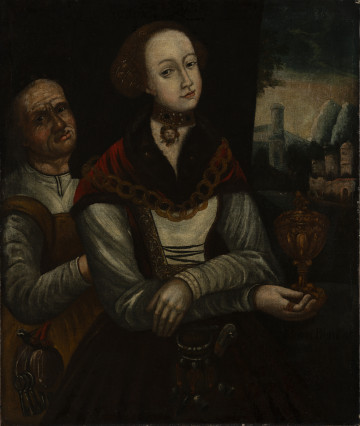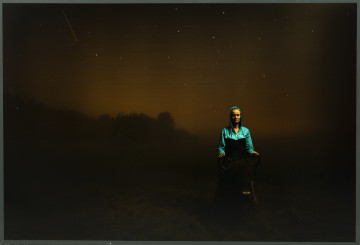
Sidonia von Borcken gestalt in ihrer Jugend wie ihrem Alter | Sidonia von Borcke represented as a young and old woman
1701 — 1800
National Museum in Szczecin
Part of the collection: European painting
The Lesson of Singing by Louis de Silvestre is an allegorical painting created between 1740 and 1748. From 1716, the French artist was a court painter in Dresden. After the accession to the throne of August II and later August III, he was also active in Warsaw. The extraordinary success of his paintings prompted the painter to create a large art workshop with numerous disciples and copyists employed there. Distinguishing a workshop copy from the original requires careful analysis.
The unsigned painting from Lublin is highly artistic due to the correct drawing, excellent painting technique, and light, delicate colour.
The scene shows two female half-figures with strongly contrasting complexions. The foreground figure is fresh and youthful, with a light complexion. The darker colour of the complexion of the woman in the background emphasises her old age. The contrast between old age and lush youth has been a theme of interest to painters for centuries. The fascination with the stages of human life also resounds in the Lublin painting. However, it lacks the necessary expressive power to convey important spiritual and moral messages. It constitutes a representation typical of the Rococo style, intended mainly to please the eye and decorate the interior. Elements from the music world, i.e., a sheet of music in the young girl's hand and a viola da gamba in the older woman's hand, are the key to deciphering its meaning. The unusually intimate atmosphere of the canvas evokes unequivocal erotic associations. That may be popular from the 17th-century representation of the type ‘who sells her favours’, a composition showing a Mac Daddy and a young girl being introduced into the dubious arts of love for sale. Another source of inspiration for the painter may have been the love story of Vertumnus and Pomona, known from Ovid's Metamorphoses.
Vertumnus, the god of the changing seasons, fell in love with Pomona, the goddess of the harvest. Indifferent to the advances of suitors, she spent her days working in orchards. Vertumnus came to her in the form of an older woman, who extolled his virtues to make the chosen one interested in him as the best candidate for a husband. His words did not make the right impression on Pomona, but his appearance in his youthful form delighted her and won her favour. With this interpretation, the happy ending and the love of the gods are shown by making music together.
Magdalena Norkowska
Author / creator
Dimensions
cały obiekt: height: 60 cm, width: 80 cm
Object type
painting
Technique
oil technique
Material
canvas, oil-based paint
Creation time / dating
Creation / finding place
Owner
The National Museum in Lublin
Identification number
Location / status

1701 — 1800
National Museum in Szczecin

1805 — 1814
National Museum in Szczecin

2011
National Museum in Szczecin
DISCOVER this TOPIC
National Museum in Lublin
DISCOVER this PATH
Educational path